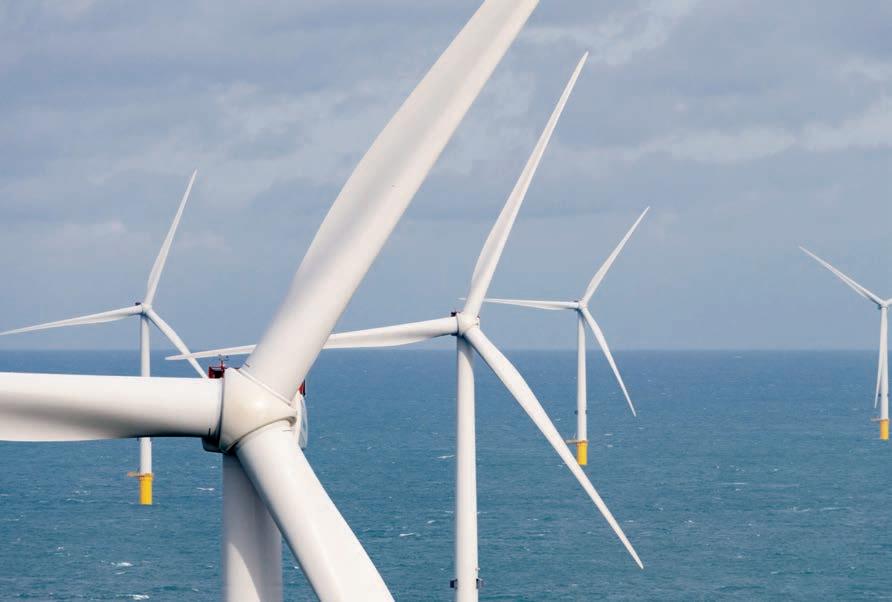
3 minute read
Ørsted and Vestas partner towards net-zero wind farms
Ørsted and Vestas recently announced a commercial sustainability partnership. Ørsted will procure lowcarbon steel wind turbine towers and blades made from recycled materials from Vestas in all joint ofshore wind projects.
The deployment of ofshore wind is crucial to enhancing energy security, advancing afordable energy for all, and not least curbing the climate crisis. Today, wind produces energy with a 99% lower carbon footprint than coal, but on the scientifc path to net-zero, we must limit the carbon that the manufacturing of materials and components used in wind farms emits. This is also being increasingly demanded by consumers of renewable energy and policymakers. Meeting this need requires cost-efcient solutions to address the most critical decarbonisation and circularity challenges in the wind industry, namely steel and blades. To address these challenges, Ørsted and Vestas will install low-carbon steel towers and, when commercially available, blades made from recycled materials at all future joint ofshore wind farms.
Unprecedented scale and pace
By committing to integrate sustainable procurement, not just as a one-of but in all future ofshore projects between the two companies, Ørsted is creating ongoing demand for Vestas’ innovative low-carbon and circular solutions. Mads Nipper, Group President and CEO of Ørsted, says, “There’s no playing defence when it comes to climate change. And there is no progress without partnerships. That’s why we at Ørsted are very proud to partner with Vestas to integrate and scale cutting-edge decarbonisation and circularity solutions to meet future customer demands for net-zero wind farms. Together with Vestas, we’re leading the industry towards net-zero, and I urge decisionmakers across the globe to also take action and help drive demand for lowcarbon and circular solutions within renewable energy.” Henrik Andersen, CEO of Vestas, states, “The energy transition requires unprecedented scale and pace, and we need strong partnerships between leading companies and industries to succeed. We are excited to partner with Ørsted to expedite the deployment of our cuttingedge circular blade recycling technology and foster the demand for low-carbon steel in the wind industry’s supply chain. This partnership is a leap forward for developing circular wind power projects and sends a powerful message that commercial agreements and collaboration are vital in our urgent fght against the climate crisis.”
Leading the industry
Ørsted and Vestas have been leading the renewable energy industry towards a sustainable build-out of wind energy, while increasing scale and reducing costs. Ørsted and Vestas were the frst renewable energy developer and manufacturer, respectively, to have validated 1.5°C-aligned science-based targets for decarbonisation of the entire value chain, and both companies have implemented supplier decarbonisation and engagement programmes. They are also committed to solving the industry’s biggest circularity challenge, ending landflling of blades, making the companies natural partners to take the next steps together towards net-zero wind farms. Apart from the commitments on low-carbon steel towers and circular blade recycling, the companies have also pledged to explore other areas of collaboration within sustainability, including within biodiversity to ensure a build-out of renewable energy in balance with nature. i. orsted.com i. vestas.com
The partnership
The partnership entails that for all joint future ofshore wind farms, the two companies will:

Procure and install a minimum of 25% low-carbon steel towers in joint projects.
Over the last years, Vestas has spearheaded cross-industrial collaboration to establish availability of low-carbon steel for wind turbine towers. With the new partnership, Ørsted and Vestas are sending a strong demand signal to the steel industry to further accelerate the scaling of costcompetitive decarbonised steel for ofshore wind. By utilising scrap steel manufactured with on-site renewable electricity, carbon emissions from heavy steel plates used in towers can be reduced by up to 70%.
Scale circular blade recycling technology and procure blades made from recycled materials.
Vestas and its partners in the CETEC project have pioneered the frst solution to break down composite materials in both existing and future epoxy-based blades and use the recovered epoxy resin for new blades. This addresses the industry’s biggest circularity challenge, namely the many blades in operation today that need to be recycled at their end-of-life. Vestas is currently scaling up the circular recycling value chain together with its partners Olin and Stena Recycling. When ready for commercial manufacturing, Ørsted will procure wind turbines blades made from recycled materials from Vestas to further accelerate the scaling of the technology.









